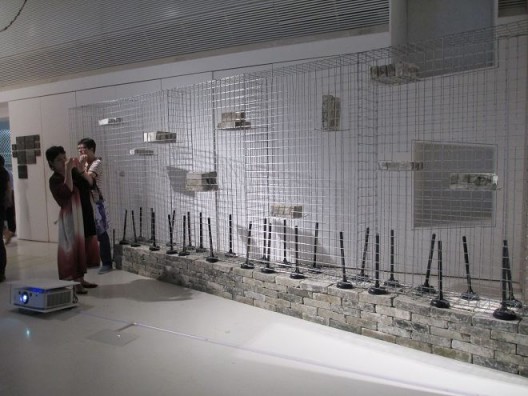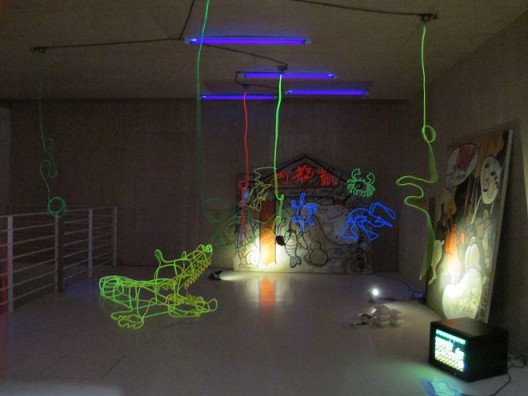“Operation PRD—Big Tail Elephants: One Hour, No Room, Five Shows”
Guangdong Times Museum (Times Museum, Times Rose Garden, Huangbian Bei Lu, Baiyun Dadao, Guangzhou, Guangdong), Jun 14 – Oct 7, 2016
Of all the avant-garde artistic groups and collectives in today’s research agenda, a group rather seldom mentioned is the “Big Tail Elephant Working Group” (aka Big Tail Elephants; Daweixiang) active in the southern province of Guangdong in the 1990s. The most comprehensive introduction to the group must surely be the exhibition “Operation PRD—Big Tail Elephants: One Hour, No Room, Five Shows” curated by Hou Hanru and Nikita Cai at Guangdong Times Museum. And the references in the title? “One Hour” originates from “One Hour Game” by Liang Juhui; “No Room” harks back to an exhibition the Big Tail Elephants held in an apartment on No. 14 Sanyu Road, Guangzhou, back in 1994; and “Five Exhibitions” is the number of exhibitions the collective put up during the 1990s. The curators’ focus on Big Tail Elephant’s role in the art world in Guangdong, and indeed the rest of China, has everything to do with the particular regional specificity of the Pearl River Delta.
China saw its peak in avant-garde artists forming collectives and organizing exhibitions during the 1980s. In a cultural landscape still dominated by officialdom, engaging in various kinds of activity in the name of a collective was one of the most effective means for artists to find a voice. As one art historian has noted how between 1982 and 1986, 79 young artist collectives were formed in 23 provinces or province-level regions who organized 97 events (Lü Peng, A History of Art in 20th Century China). These groups formed in order to arrange an exhibition and they frequently dissolved after just a few showings to the public.
The emergence of Big Tail Elephant, however, happened after this peak. Unlike what sparked the formation of similar groups in the 1980s, the Big Tail Elephant—established in 1991 by Lin Yilin, Liang Juhui, and Chen Shaoxiong—did not, as its chief collective aim, seek to resist official governmental criticism or to fight for more chances to exhibit. In contrast with what was happening in the capital, Beijing, Guangzhou—the center of the broader Pearl River Delta region—seemed much freer both politically and culturally. The three artists, having already worked together in the “Southern Artists Salon” [Nanfang Yishu Shalong] in 1986, got together simply because their ideals and paths aligned.
Looking back at all this from the point of view of the present, the importance of how the curators are reframing the Big Tail Elephants lies in the fact that the collective was, in its time, very unusual. At the turn of the 1990s, when northern China had scarcely begun the transition to a market economy, Guangzhou, neighboring Hong Kong, had already become a city centered on consumption and entertainment. In contrast with a cultural landscape steeped in Socialism, artists in Guangzhou were much more in tune with the rapid processes of urbanization. While artists in the north such as Wang Guangyi, Fang Lijun, and others were resisting consumerism with ideologically-laden political symbols, the Big Tail Elephant Group’s works were more about intervening from a local, everyday level—this could really be one of its most distinct characteristics. They employed materials that were close at hand and sought inspiration in the sorts of phenomena found in ordinary life. In contrast with those other northern works—against the system, self-mocking, individualized—we seem to be able to glimpse through works by the Big Tail Elephants the environment as lived by a particular group of people in a particular region at a particular time. It is more of a diary, and less of a manifesto.


Modernization and urbanization were often accompanied by the large-scale demolition of old buildings. And so abandoned bricks became a familiar material for the artist Lin Yilin, as in his 1992 piece “Household Goods” where on top of a winding brick base a lightweight “wall” made of metal mesh is built; several bricks are inserted within, and this impression of suspension imparts this sensation of demolition and construction at once. Or Chen Shaoxiong’s “72.5 Hours of Electricity Consumption” (1992), which employed the colorful neon normally used in such sites of consumption as tai paai dongs [daipaidang in Mandarin, or “street-side stalls”], hotels, and karaoke halls. Shaping variegated neon tubes into a human figure with a transparent raincoat wrapped over the top gives the impression of the sort of hazy reverie one sees in an urban nightscape. When the work is turned on, an electric meter on the side begins counting the electricity consumed—as though hinting at that silent passing of time through leisure in sites of consumption. Also displayed is Liang Juhui’s “Paradise” (1994): along with its pleasing title, the glass pieces filling the space and the many lights decorating it conjure a dreamy, seemingly infinite spatial effect. Yet the bamboo poles crisscrossing inside the work remind one of the scaffolding used in construction. Using construction detritus and repair materials found on the street, Big Tail Elephant fuses consumerist ideas of creation with the actual living environment.
The second salient characteristic of the Big Tail Elephant Group was how they made their own space at a time when there were no set exhibition spaces. In 1993, for instance, the third “art event” of the Big Tail Elephant Group was held outside the Red Ant Bar where they frequently met; in 1994, meanwhile, the “No Room” exhibition was carried out in an apartment Liang Juhui found (on No. 14 Sanyu Road, Guangzhou). The title of the exhibition (which was curated by Hou Hanru) also happened to point out how in the 1990s, Guangzhou, distant as it was from the cultural capital of Beijing, had no institutions that could show experimental art. As far as Big Tail Elephant was concerned, their way of working outside a studio lowered their artworks’ dependence on any exhibition space to a minimum. What is more, unlike other artists with a studio, they were without a set place and so often paid particular attention—even in the process of making something—to the possibility of displaying it in a public space. One example was “Safely Maneuvering across Linhe Road”, created in 1995 by Lin Yilin, where the artist reflected on the relationship between people and architecture. In the Tianhe district of Guangzhou, then still being built and developed, Lin carried out a performance where he “moved” a brick wall from one side of the street to the other (causing a small-scale traffic jam in the process). In another work, “One Hour Game”, Liang Juhui played a video game (“Battle City” from 1989, in case you were wondering) in the only elevator in a construction site, thus temporarily transforming an elevator that every day transports hundreds of workers into an arcade, and temporarily halting construction. Through these quiet, unobtrusive actions, the two artists unveiled the madness of the speed of urbanization.

This exhibition at Guangdong Times Museum presents over twenty works by the Big Tail Elephants when they were still a group (composed of Lin Yilin, Liang Juhui, Chen Shaoxiong, and Xu Tan, who joined in 1992). In this, aside from the “originals” of performance-related documentaries and the video works, the vast majority of the artists’ works are presented in the form of images, or else have been meticulously replicated by museum volunteers according to the dimensions in the photographs. By putting up partitions, some of the works were positioned rather aptly. For instance, Lin Yilin’s “X Billion-and-First Person III” not only recreates the work which was displayed in the Kunstmuseum Berne in Switzerland in 1998, it also restores its relationship with Liang Juhui’s work “Construction of a Place and Ants” in the same space. As the first stage of the “Operation Pearl River Delta”, the curators especially emphasize the intimate relationship between the Big Tail Elephant Group’s artistic oeuvre and the urbanization of the surrounding city. In terms of content, the “Chronology: 1986–2005” on the walls not only starts from the Southern Artists’ Salon and sorts through the collective and its members’ activities organized in this period (as well as later exhibitions each of them took part in individually), it also notes some important events that took place in Guangzhou and around the world.
One part of the exhibition space is covered by black curtains; inside are colored plastic chairs and folded tables, mimicking one of the elements of urban culture in the Pearl River Delta, the tai paai dong / daipaidang (or casual street-stall eateries). The other element is the culture of renovation, which is presented as part of the exhibition design with the look of renovations and repairs—think bare plywood separating the spaces, and grayish paint resembling exposed concrete.



